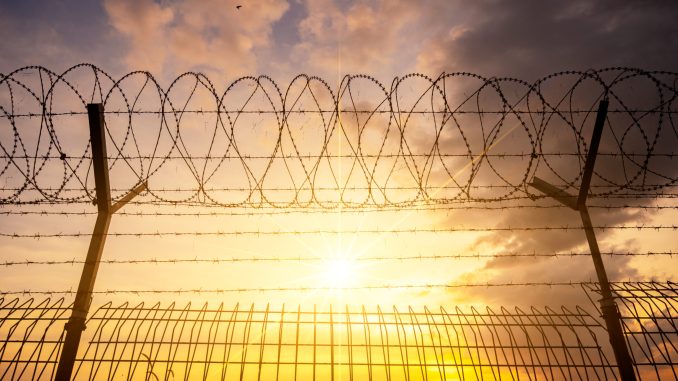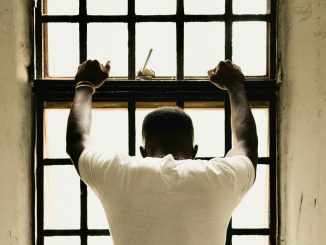
Where prisons are located, the way they are built, and the health condition of prisoners means deaths will likely increase with climate change, experts say.
By Hilary Beaumont, Capital & Main
This story is produced by the award-winning journalism nonprofit Capital & Main and co-published here with permission.
Lawrence Cox often found himself drenched in sweat while pushing heavy kitchen carts inside High Desert State Prison in Susanville, California. He and other incarcerated workers had no access to air conditioning, so they came up with a strategy for working in extreme heat.
“We wet our clothes, or wet our shirt and we put it on, and that’ll help draw some of the heat out of our body and keep us cool,” he said. “You do have to repeat that process sometimes, because it’s so hot, the shirt dries real quick.”
Cox said the heat stress while working was so intense that it was hard to breathe, he felt dizzy and exhausted, and he became easily dehydrated. “I remember a time where I had extreme muscle pain because I became [so] dehydrated.”
Cox was released from prison in 2023. This year, California adopted indoor heat standards for workers — but prisons were exempted because officials said they could not determine the cost to implement the new rules.
In September, California prisons, many located in the hottest parts of the state, baked under a record heat wave. The climate crisis is driving more frequent and deadly heat waves, increasing the urgency of installing heat protections in prisons.
California is among the top states for hazardous heat risks to incarcerated people. Bharat Venkat, associate professor at the University of California, Los Angeles, and director of the UCLA Heat Lab, said he expects deaths and illness to increase as the climate warms. The state, he said, must act before the next season of extreme heat. “In California specifically, I think we need some sort of indoor heat standard for prisons and jails immediately,” he said.
There are approximately 95,000 inmates in California’s prisons. About 40,000 of them are employed in various jobs. California state law requires incarcerated people to work. Those who refuse to work may be penalized with time added onto their sentences.
In California prisons, Cox said access to ice or cold water was considered a privilege that could be revoked as punishment. Small fans were available only to those who could afford them. He said a fan costs about $25. His family on the outside gave him money to buy one, but he said not everyone is so fortunate.
Cox was convicted of home invasion robbery in his early 20s. He was incarcerated for 17 years in California and other states until his 2023 release. He performed janitorial and kitchen work in multiple prisons, earning at most 13 cents an hour.
At another California prison, Solano State Prison, Cox sought medical attention after breaking out in a heat rash. He saw people overwhelmed by the heat. “One of the older individuals actually had a heat stroke,” he said. “I remember medical staff taking forever to respond.”
In July, 47-year-old Adrienne Boulware died at the Central California Women’s Facility amid a heatwave. Some 66% of people imprisoned in California report experiencing extreme heat, and 60% said they never had access to air-conditioned rooms during extremely hot days, according to a 2023 survey.
When Cox heard about California’s decision to exempt prisons, he saw it as part of a system that fails to recognize the humanity of incarcerated people.
“It infuriated me,” said Cox, who is now an advocacy and organizing associate with Legal Services for Prisoners with Children. “It made me flash back and remember that still, now, they still do not feel like we should be humanized.”
Heat Rules Needed ‘Immediately’
Heat waves in California are becoming more frequent, and average summer temperatures have increased by three degrees Fahrenheit since 1896. Of all weather events, extreme heat is the deadliest — causing more deaths than hurricanes, floods or tornadoes.
Recognizing the danger, advocates in California have pushed for years for an indoor workplace heat standard. In March, the state was on the verge of passing an indoor heat standard, but as a key vote approached, the Department of Finance withdrew its support, noting that the cost to prisons could be in the billions of dollars. As a result, the California Division of Occupational Safety and Health (Cal/OSHA) voted to pass a workplace heat rule that exempted prisons. The rules took effect in late July.
Before proposed regulations can go forward, they are sent to the Department of Finance for review. Spokesperson H.D. Palmer told Capital & Main that the Department of Finance wasn’t “able to arrive at a reasonable methodology to determine public sector costs [between the Department of Industrial Relations] and affected agencies within the specified timeline for the regulation to go forward.” He did not respond to questions about how the department arrived at a cost estimate of “billions” of dollars.
California’s Department of Industrial Relations announced the standard in June, adding, “Cal/OSHA is in the process of developing an industry-specific regulation for local and state correctional facilities to protect their workers from indoor heat hazards.” The department said it would continue investigating reports of indoor heat violations.
In an emailed statement, the Department of Industrial Relations, which includes Cal/OSHA, did not give a clear timeline for an industry-specific heat regulation for correctional facilities. “We remain committed to further addressing indoor heat at prisons and jails,” an agency spokesperson wrote. “In the coming months we will be evaluating various options through an industry-specific regulatory process.” The department said that the process requires steps including formal notice and comment, an economic analysis, adoption by the state’s occupational health and safety board, as well as legal approval.
UCLA’s Venkat explained that prisons are often built in places that are especially hot. “People don’t want prisons in their backyards, and so prisons are often in places that are less desirable, which tend to be hotter places,” he said.
They are also built with materials that absorb and retain heat, and lack windows that can open to allow air flow. Most facilities lack central air conditioning, he said.
Incarcerated workers’ jobs often require physical labor. They work in industrial manufacturing, making furniture, eyeglasses and license plates. Some work in factories baking bread and bottling peanut butter. Incarcerated workers also weld with hot tools, cook over hot stoves and fight wildfires.
Access to showers and fans is restricted in prisons. Unlike those who are not in prison, inmates cannot travel to a cooler location. “In a carceral facility, you really are stuck,” Venkat said. “You don’t have that choice. You can’t make a decision to take care of yourself.”
Venkat noted that many incarcerated people are prescribed psychiatric drugs, some of which decrease one’s ability to thermoregulate one’s body. A 2023 survey of California inmates found 36% were taking psychiatric or other medications that put them at risk when exposed to heat.
Venkat added that inmate complaints get lost, or aren’t taken seriously. “So even getting a remedy for heat-related issues is difficult,” he said.
Incarcerated Workers Lack Job Protections
During a heatwave in July, Rita Lomio, a senior staff attorney with the Prison Law Office, visited a prison in Corcoran, California. She said when she visited the facility in the scorching Central Valley, temperatures moved well above 110 degrees Fahrenheit.
Lomio said the prison lacked heat mitigation measures — the ice machines were broken, and there was no air conditioning. ”People were extremely agitated, sweating profusely,” she said. “It was really horrifying how inhumane it was.”
She said incarcerated workers were doing jobs in unsafe conditions. “The kitchens in particular are just stiflingly hot,” she said.
Incarcerated workers operate under a different set of rules from other workers, she said. They are unable to unionize, and they face punishment if they refuse to work.
“Working in prison isn’t voluntary,” she said. “That’s state law. If you refuse to work, you are denied certain privileges, and they’re significant.”
For instance, incarcerated people can earn “good conduct credits” to reduce their time in prison. But if they refuse to work, they can be denied these credits, and will be imprisoned for longer.
The 13th Amendment outlawed slavery across the United States, except as criminal punishment. “Forced labor in prison is slavery,” Lomio said.
Lomio said prisoners working in California may file complaints about unsafe working conditions. However, there are so few jobs that people are less likely to complain about unsafe conditions because they fear losing work.
For workers who are imprisoned, Cal/OSHA does enforcement, outreach and training under the Heat Illness Prevention Special Emphasis Program, and the agency investigates potential indoor heat violations, the Department of Industrial Relations spokesperson wrote in an email.
The agency can make recommendations related to the working conditions of people incarcerated in state prisons, and if the California Department of Corrections and Rehabilitation does not comply, Cal/OSHA may issue orders, rules or regulations, according to Lomio.
The attorney said that under the Eighth Amendment, prison officials have a duty to ensure people are provided adequate shelter, including temperatures that don’t threaten their safety. Lomio said the state is not meeting its legal obligations.
“The incarcerated population are totally in the control and custody of the state, but they’re disenfranchised and just ignored,” she said. “And it’s not legal, first of all, to subject people and confine people in these unsafe conditions. It’s certainly not acceptable to have them work in these unsafe conditions.”
Lomio said that the status quo exists due to a lack of political will. “It can be difficult for political actors to feel comfortable giving the money to a prison system full of people who don’t vote,” she said.
Lomio said the Prison Law Office is now advocating for policy changes through previous court rulings. “If there’s a lack of political will, then you would have to go to the courts,” she said.
Venkat suggested a solution for how the state can afford to retrofit prisons to add air conditioning: “A lot of correctional facilities in California are not at capacity, so if you move some folks into other facilities, and if you let some people out, you can close down a bunch of facilities, and you can use the savings to cool the rest of them,” he said.
H.D. Palmer of the state Department of Finance declined to comment on Venkat’s suggestion. “Those types of issues would likely be considered as part of the regulatory development process,” he said.
Cox said one solution is Proposition 6, a ballot measure that is going before voters in November and would amend the state Constitution to end forced labor in prisons.
Specifically, it would continue jobs for incarcerated workers, but would prohibit punishments such as extra time on sentences for those who refuse to work.
“Finally, it will be going to the ballot,” said Cox, with Legal Services for Prisoners with Children. “It’s all about restoring human decency and monetizing rehabilitation over exploitation.”
“People don’t like to hear it’s slavery, but I mean, involuntary servitude — you force someone to do something for nothing, or for pennies, and then punish them if they choose not to — I believe that is very akin [to], and mirrors, a system of slavery that built this state, this country, that we all live in now,” he said.
Copyright 2024 Capital & Main


Be the first to comment